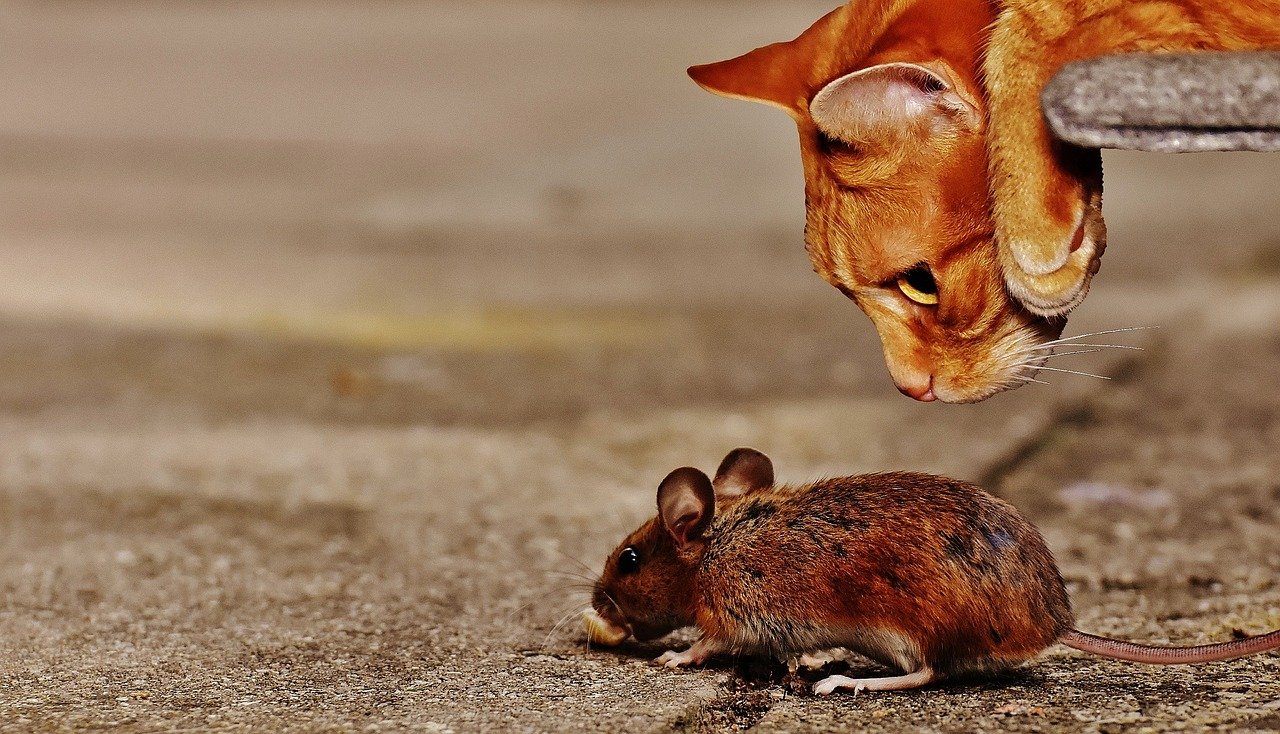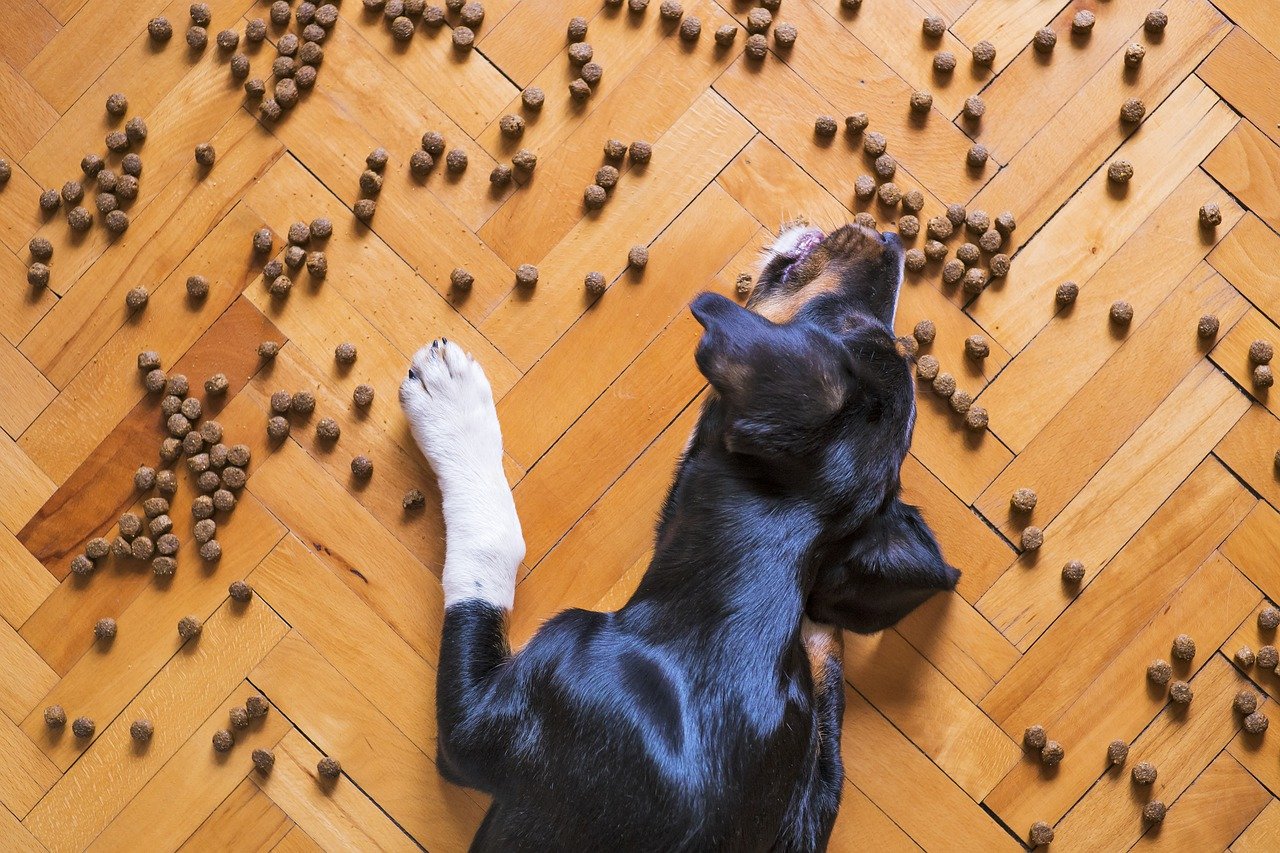Myth 1: Dry food cleans your teeth
Tartar is caused by deposits of calcium salts from saliva on the teeth, which calcify and harden over time. Many dogs and cats deal with tartar, so it's no wonder that foods are advertised as reducing tartar without work and brushing. By chewing the dry food, the dog or cat should rub off the tartar and get clean teeth again in the long term.
In reality, however, it is more the case that both dogs and cats simply swallow the dry food without chewing. The crumbs of the dry food between the teeth are then much more a good breeding ground for bacteria and gum inflammation can occur.
Myth 2: Food should be available all day
Contrary to most herbivores, constant feeding is not common in predatory animals such as dogs and cats. While cats, as loners, devour many small meals throughout the day, pack hunters really fill their stomachs. Since the dog's stomach is very, very stretchy, you hardly manage to really fill it. Therefore, they do not have a feeling of satiety as we humans know it, but could actually eat a lot more. While in nature the success of the hunt determines how much food there is, for most dogs an always full bowl leads to overeating. Leaving the food standing does not usually help with the fussy representatives. It encourages nagging even more as the dog knows he can always eat if he wants to.
Myth 3: Raw meat makes dogs aggressive
This myth is old, but still persists. "If you give the dog raw meat, it will then bloodthirsty hunt sheep, rabbits or deer."
There is no basis for this myth and in the meantime, dog training and dog psychology have also dealt intensively with the topic of aggression in dogs. This can have many causes, such as pain, bad experiences, fear or misalignment. The hunting instinct in dogs is also genetically determined in many breeds, but the dog also learns through experience. Because hunting success or chasing is a self-rewarding activity for dogs. Food envy can also lead to the dog aggressively defending its food - but it doesn't matter whether it's dry food or fresh meat.
Myth 4: Too much protein puts a strain on the kidneys
This myth is widespread, but has nothing to do with reality. Proteins are the building blocks of life - without them nothing works in the body. They take on many important functions and are, among other things, building materials for cells and tissues, enzymes, hormones and antibodies.
Cats, as strict carnivores, have a much higher protein requirement than dogs and high-quality, species-appropriate food is even more important for them. What you have to look out for when it comes to the protein content is that it is high-quality, primarily animal protein. This contains all the important amino acids that are important for the body of dogs and cats. In turn, bad protein is broken down by bacteria in the large intestine, producing pollutants such as ammonia, which have to be metabolized in the liver and excreted through the kidneys, putting a strain on these organs if too much is produced.
Therefore, always check the form in which proteins are contained in the feed and make sure that the proportion of inferior proteins (e.g. udder, lips, tripe) is kept within limits.

Myth 5: Slaughterhouse offal in feed is inferior
Ingredients such as "animal by-products" are often found in the declarations of feed. It quickly becomes apparent that the manufacturers use things like hooves, horns, feathers and fur. However, according to the Feedstuffs Act, this term includes all those parts of the slaughtered animal that are not used for the production of food for humans. These are components such as offal (liver, kidneys, spleen, heart and lungs), tripe / omasum, tongue, udder, skin, bones or blood, which make up around 40% of the slaughtered animal. For dogs and cats, these raw materials represent valuable, nutrient-rich components and are wrongly often demonized. However, it is always desirable to have an open declaration from the manufacturer so that you can really see what is in the food.
Myth 6: Milk is healthy for cats
You can still see people putting milk outside for the stray cats. Most cats love milk - no question about it. The problem with this is that milk contains lactose (milk sugar). And only kittens have enough lactase to digest milk sugar. When kittens are weaned and switched to solid food, the production of lactase decreases. Like a lactose-intolerant person, cats can then develop digestive problems such as diarrhea or flatulence from milk. The digestibility of lactose also no longer increases when milk is given again. If you want to pamper cats a bit, you should use lactose-free milk products.

Myth 7: Raw food is dangerous and transmits disease
No one has ever been afraid of mouse-catching, outdoor cats who routinely munch on "fresh meat." With raw food, however, emotions run high and wild rumors are spread about how dangerous raw meat is for dogs and cats.
Of course, raw meat is not sterile and contains germs such as various bacteria. However, this does not automatically mean that raw meat is also dangerous and that animals get sick from it. In order to prevent the meat from becoming too contaminated with germs, it is important to pay attention to the quality and to comply with the hygiene rules in the kitchen. Proper thawing and processing is essential, as is handling kitchen utensils and washing hands after preparation. Anyone who pays attention to this need not be afraid that the animal or you yourself will become ill from raw food.
Myth 8: Grains are unhealthy for dogs
The trend is going more and more towards "grain-free" feed, as grain is notorious for being unhealthy and causing allergies. First of all - grain has no place in cat food, since cats are carnivores and their digestion and metabolism cannot do anything with carbohydrates and therefore grain.
Carbohydrates such as grain are certainly not an essential nutrient for dogs, but they can still be important for the animal in certain life situations.
In addition to fat, carbohydrates are important suppliers of energy and can be used if the dog does not tolerate fat well or has a very high energy consumption, such as with sporting dogs.
Feeding a small proportion of carbohydrates in the form of grain or pseudo-grain is also not a problem for normally active dogs. They also provide fiber, which is important food for the good intestinal bacteria. However, it is important to pay attention to the types of grain used (e.g. millet or oatmeal) and that the dog tolerates them well. But the dog can safely do without things like corn or soy.
Myth 9: Bones are dangerous for dogs
Bones contain many minerals such as calcium, phosphorus and magnesium. They are therefore an important part of the feed, especially in raw feeding. However, it is important to feed the right amount and the right types of bones. In addition, NEVER feed bare bones, but always bones that are coated with meat, so-called raw meat bones. Poultry bones, rabbit, lamb ribs, goat or venison are suitable here. In addition, the animal should be slowly introduced to bone feeding.
One should NEVER feed supporting bones, as these are too hard and damage the teeth of the animals. Cooked bones are also an absolute no-go! Due to cooking, they lose their elasticity and become splintery, which can lead to serious injuries. In animals that are not otherwise fed raw, you should generally be careful with bones. Overfeeding raw bones can lead to bone droppings, which is very painful for the animal and, in the worst case, can require a trip to the vet ! Therefore, do not get overconfident and give huge bones, but always the right amounts and in such a way that the animal can tolerate them. Dogs should never eat bones unsupervised.

Myth 10: Fat makes you fat
Fat has a very bad reputation with us humans, because fat makes you fat - doesn't it?
Fat is a very important supplier of energy and dogs and cats urgently need fat for their metabolism. Cats in particular are very fat-loving carnivores and tolerate a lot of fat much better than dogs. Adequate animal fat content is also important for cats because it provides them with the essential arachidonic acid . It is therefore important that the feed of healthy animals also has a certain fat content so that the feed is supplied with sufficient energy. If it is no longer possible to feed enough fat due to certain diseases, it is important to find good alternatives so that the animal does not have to rely on the breakdown of proteins as an energy source, as this puts a strain on the kidneys in the long term.










